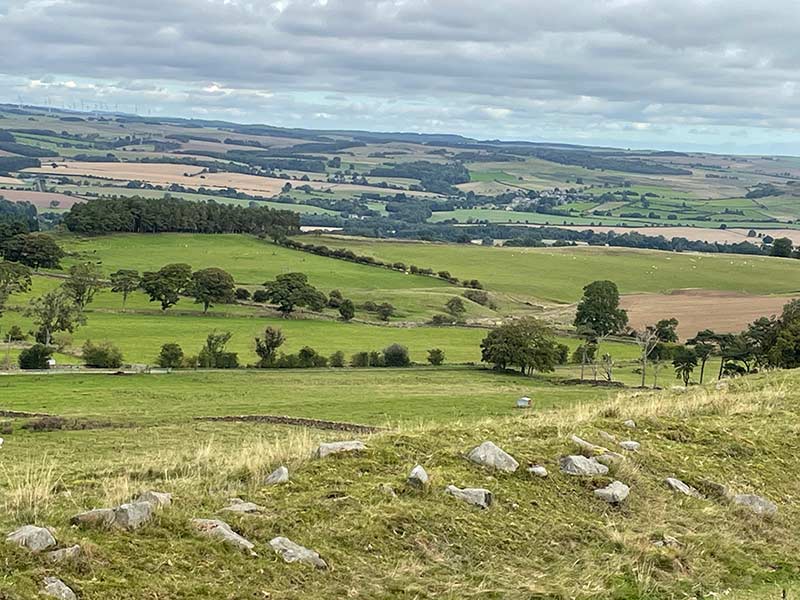The Great Beyond
I’m currently perched atop Hadrian’s Wall in Northern England near the Roman fort of Vindolanda. The weather is uncharacteristically pleasant. That means I can extract my laptop without electrocuting myself in a rain storm. It’s the off season, so there are relatively few people around.
I sit on these craggy rocks and peer north, imagining what the poor shmucks who built this thing must have thought some two millennia ago. The wall itself is 73 miles long and includes sixteen integral forts. The entire edifice is comprised of millions — no billions — of hand-hewn stones meticulously stacked and held together with cement made from cooked limestone. Begun as a result of an edict by the Emperor Hadrian in 122 AD, his eponymous wall remains a truly breathtaking thing even today.
Nearly 2,000 years ago, this was the literal edge of the world. The Romans had pushed out as far as they were physically able and then just declared enough was enough. The wall demarcated the line between Roman Britannia to the south and Caledonia to the north. While Hadrian’s Wall never has been the national boundary between England and Scotland, it is close. It seems nobody ever quite successfully domesticated the Scots.
And that is what is so fascinating about this place. I sit here reverently listening to the wind whistle softly around. In the distance, a veritable sea of windmills stand in mute testament to the UK’s commitment to green energy solutions for a safer, cleaner tomorrow. Nearly two millennia ago, however, this place would have seemed very, very different.
The typical Roman legionary stood five foot seven. He was expected to carry nearly 100 pounds on a 20-mile forced march spanning five grueling hours in all manner of weather. And that is without Gortex snivel gear, Danner boots or MOLLE load-bearing equipment. Organized into 80-man centuries and 5,000-man legions, Roman military formations quite efficiently conquered the entire known world. Yet those who sat atop this wall stared north, and they were afraid.
What stretched north beyond the wall was an abyss, a dark void that consumed soldiers without pity or remorse. Little was known about that place or those who inhabited it, save for that they were fearsome. It was a bit like outer space is today. It was unconquered, unfathomable, and intimidating, so Hadrian just built a wall to keep it at bay.
We humans build walls — both physical and metaphorical — for lots of different reasons. Such is entirely appropriate. If one of my rural neighbors chose to amass a modest saltwater crocodile collection, I’d welcome some kind of barrier between his space and my own. It is likewise eminently sensible to secure one’s national borders. This deep into the Information Age, a great deal of mischief in the form of criminals, terrorists, drug runners, and human traffickers can be found transiting porous unsecured borders. However, there is also a timeless drive to erect psychological boundaries that differentiate what we know from what we do not. The unknown is timelessly terrifying. This is part of the human condition.
In A.D. 122, it was the barbarian savages to the north of the wall. Today, it is that inky black spot between the stars on a dark moonless night. Hadrian built his wall because he feared what he did not understand. We modern humans boldly proclaim that we have outgrown God when in reality we cannot even explain whatever it is that resides above our heads 24 hours a day, seven days a week. That inky black spot goes on forever. It never, ever stops. This is undeniably terrifying if we allow ourselves to dwell on its particulars unduly. I personally love that.
That simple observation seems to so perfectly put human scientific endeavor in its proper context. We understand a great deal about what we can touch and feel. However, you get just outside our metaphysical boundaries and the universe becomes even bigger and more unfathomable than it ever was in Hadrian’s day. Even this deep into the Information Age, we still remain so terribly small.
Nearly 2,000 years ago, a young Roman legionary sat on this self-same spot and cerebrated upon the same sorts of stuff I am pondering today. He was no doubt younger and more fit, but he dreamt of peace, home and stability — the same things that drive my train. As I sit here, comfortably typing atop Hadrian’s Wall, I am simply struck by how little about the human experience ever actually changes.







